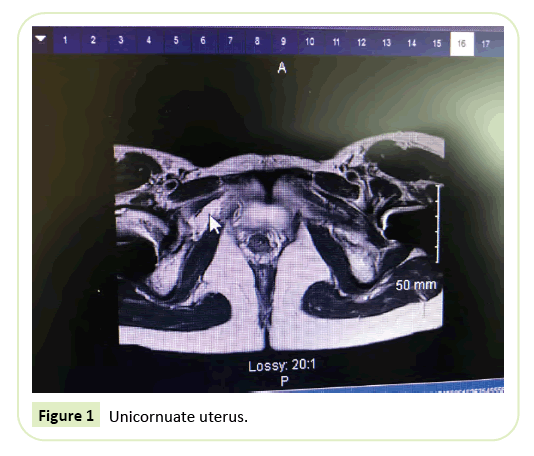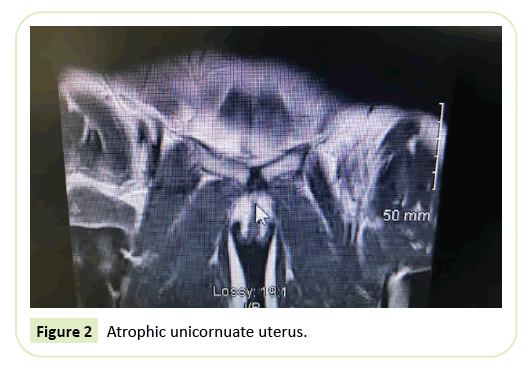Mohamed Abdelrahman1*, Michael Geary2 and Vineta Cipreke3
1Royal College of Physicians of Ireland, Dublin, Ireland
2The Rotunda Hospital, Dublin, Ireland
3Our Lady of Lourdes Hospital, Drogheda, Ireland
- *Corresponding Author:
- Mohamed Abdelrahman
Royal College of Physicians of Ireland
Dublin Ireland
Tel: 00353873987464
E-mail: mohamedgarelnabi@gmail.com
Received Date: December 12, 2019; Accepted Date: December 31, 2019; Published Date: January 07, 2020
Citation: Abdelrahman M, Geary M, Cipreke V (2019) A Report on an Unusual Case of Mullerian Duct Anomaly (MDA). Vol.5 No.3:81
Background: In embryology uterus, upper 2/3 of vagina and fallopian tubes derived from paired mullerian ducts. Crosby proposed fusion of the two Mullerian ducts starts caudaly in Muller's tubercle, proceeds cranially up to the fundus. Failure of ducts to develop leads to types of uterine, cervical or vaginal agenesis while incomplete fusion results in uterus didelphys. These congenital anomalies occur in 1-15% of women associated with renal anomalies especially agenesis or ectopia. This association can be attributed to additional disturbances in other mesodermal structures. Objectives: A 32 year c/o primary amenorrhea, intermittent left iliac fossa pain and failed to develop external sexual characteristics. As a child she had hypercalcaemia, asthma, renal scaring and myopia. Had bilateral femur deformity surgery, Sting procedure, strabismus repair and septoplasty. O/E BMI 15.1, Tanner 1 breast development and pubic and axillary hair present. MRI showed evidence of unicornuate uterus in the left iliac fossa. Also right lower pelvis close to the ovary was evidence of atrophic unicornuate uterus, no identifiable vaginal vault, free fluid within the pelvis and the ovaries looked normal. Chromosomal analysis showed 46XX. Bloods revealed normal IGF, FSH, LH and low Oestrogen levels. Results: One case been reported with unicornuate uterus with two cavitated non-communicating rudimentary uterine horns (Nez., Sm.) but, the horns are on top of each other. In our case a non-caviated, non-communicating rudimentary horns laterally placed. Theory of embryogenesis: Müllerian ducts developed, the medial tract descended to the urogenital sinus. The right tract reached the sinus to rudimentary horn and its uterosacral ligament but failed to develop cervix. The left pair failed to reach the urogenital sinus and underwent atresia. Then failure of canalization is without the agenesis of one horn, the probable result would have been uterus didelphys. We do not have the histology diagnosis so cannot rule out the type of anomaly that may also favour a rudimentary horn on the left and atrophic on the right. However, normal ovaries bilaterally support the failure of fusion and canalization, rather than atrophy. Conclusion: Pathogenesis of this anomaly is unclear, but its discussion helps demonstrate the embryology of the Mullerian tracts. Treatment continues to be unsatisfactory in these cases, and would probably require in-vivo intervention in the first weeks of the embryonic period.
Keywords
Mullerian; Embryology; Anomaly
Introduction
Primary amenorrhoea is defined as the absence of menstruation by 14 years of age when there is no visible development of secondary sexual characteristics or by 16 years of age in the presence of normal secondary sexual characteristics [1]. This is a common feature in prepubertal, pregnant and before menopause in most of the women. During reproductive phase if amenorrhoea diagnosed in women then pregnancy might be the reason behind it. But if women is not pregnant then it’s a challenge to find the accurate etiology behind it. Not only loss of menstrual cycle but hair loss, acne, headache excess facial hair etc. are some of the symptoms of amenorrhea. Occurrence of irregular menstrual will lead to enhance the risk of decrease in bone density. To optimize good health a patient should support with some dietary supplements (Calcium and Vit D rich food ), proper exercise tips etc. In embryology fallopian tubes, the uterus and the upper two thirds of vagina are derived from paired mullerian (paramesonephric) ducts. Since 1967, Muller's theory about embryonic formation of female genital system has remained almost unchanged [2]. In 1957, Crosby et al. proposed that fusion of the two Mullerian ducts starts at their caudal ends in Muller's tubercle, and proceeds cranially up to the fundus [3]. Failure of ducts to develop leads to various types of uterine, cervical or vaginal agenesis while absent or incomplete fusion results in uterus didelphys. These congenital anomalies occur in 1-15% of women associated with renal anomalies especially agenesis or ectopia. The association between the uterine and the renal anomalies can be described on the basis of the Mayer Rokitansky Kuster Hauser Syndrome where the uterine agenesis associated with renal agenesis is attributed to the additional disturbances in other mesodermal structures [4]. The renal system arises from the Wolffian (mesonephric) ducts and associated disturbances in these structures leads to renal agenesis or ectopia. Vertebral bodies are also derived from the mesodermal elements but these disturbances are not clinically significant.
Case Report
A 32 year--old P0+0 presented to the gynecology outpatient clinic at our lady of lourds hospital in Drogheda, Ireland complaining of: primary amenorrhea and intermittent left iliac fossa pain on and off every few months for the past 15 years. She also had osteoporosis, hypercalcaemia, asthma, renal scarring which require annual BP check with her GP which always remained within the normal limits, and short sightedness. As a child, she had bilateral hip surgery, Sting procedure, strabismus repair and septoplasty. On examination her BMI was 15.1, she is tanner 1 on breast development and there was pubic and axillary hair present classified as tanner 2, vagina was felt as a blind pouch or dimple. MRI pelvis showed normal ovaries bilaterally, physiological follicles noted, there was free fluid in one of them reflecting haemorrhage. In the left iliac fossa there was evidence of unicornuate uterus (Figure 1), similarly in the right lower pelvis close to the ovary the is evidence of unicornuate uterus but likely atrophic. Also right lower pelvis close to the ovary was evidence of atrophic unicornuate uterus, no identifiable vaginal vault, free fluid within the pelvis (Figure 2). Chromosomal analysis showed 46XX. Bloods revealed normal IGF-1, TSH, T3 & T4, Vit. D, Prolactin, FSH, LH and low Oestrogen levels.
Figure 1: Unicornuate uterus.
Figure 2: Atrophic unicornuate uterus.
Discussion
Mullerian duct anomalies result from defects arising during development of female reproductive organs. Since Mullerian ducts are embryologically distinct from female gonads i.e., ovaries, the patient with Mullerian duct anomalies have normal ovaries [5] In the literature, only one case has been reported that is similar to ours, which was about a patient having a unicornuate uterus with two cavitated, non-communicating rudimentary uterine horns [6]. However, the described horns are stacked one on top of the other. In our case there were two non- caviated, non-communicating rudimentary horns laterally placed? Our best theory of the embryogenesis of this anomaly is as follows: each Müllerian duct developed, and the medial duplicated tract of each duct descended towards the urogenital sinus. The one tract that reached the sinus formed the rudimentary horn and its right-sided normal uterosacral ligament but failed to develop cervix. The medial tract of the left pair failed to reach the urogenital sinus and underwent atresia, producing far more attenuated ligamentous attachments than the right tract. Failure of fusion followed, then failure of canalization. Without the agenesis of one horn, the probable result would have been uterus didelphys with each horn having an attached rudimentary horn as well. Obviously, since we do not have the histological diagnosis one cannot rule out the type of anomaly that may also favor a rudimentary horn on the left side and atrophic on the right. However, ovaries bilateral to the rudimentary horns support the failure of fusion and canalization, rather than atrophy.
Conclusion
Pathogenesis of this anomaly is unclear, but its discussion helps demonstrate the embryology of the Mullerian tracts. Treatment continues to be unsatisfactory in these cases, and would probably require in-vivo intervention in the first weeks of the embryonic period. Treatment will rely on the cause and may involve a combination of medical therapy (such as hormone therapy, diet or other medication) or surgery. Earlier diagnosis and precise medical care will help a patient to get over the amenorrhoea. Sometimes acounseling from psychiatrist or social worker or sex therapist will also recommended to overcome hormonal imbalance issue caused due to any psychological trauma.
References
- Folch M, I Pigem C, Konje JC (2000) Mullerian agenesis: Etiology, diagnosis, and management. Obstetrical & Gynecological Survey. 10: 644-649.
- Muller P, Musst A, Sobal A, Winroud JC, Gillet JY (1967) Appareil urinaaire chez les povteues de malformation uterines: Etude de 1333 Observation Press Med 10: 113-118.
- Crosby WM, Hill EC (1929) Embryology of Mullerian duct system: A review day theory. Obstet Gyn 49: 799-805.
- The American Fertility Society (1998) Classifications of adnexal adhesions, distal tubal obstruction, tubal occlusions second- ary to tubal ligation, tubal pregnancies, Mu ̈ llerian anomalies and intrauterine adhesions.. Fertil Steril 49: 944–955.
- Speroff L, Glass RH, Kase NG (1998) Development of the Mullerian system. In: Mitchell C, (ed). Clinical gynecologic endocrinology and infertility. (6th edn). Baltimore, Md: Lippincott, Williams and Wilkins, UK. p. 124.
- Nezhat, CR, Smith, KS (1999) Laparoscopic management of a unicornuate uterus with two caviated, non-communicating rudimentary horns. Hum Reprod 14: 965-968.



